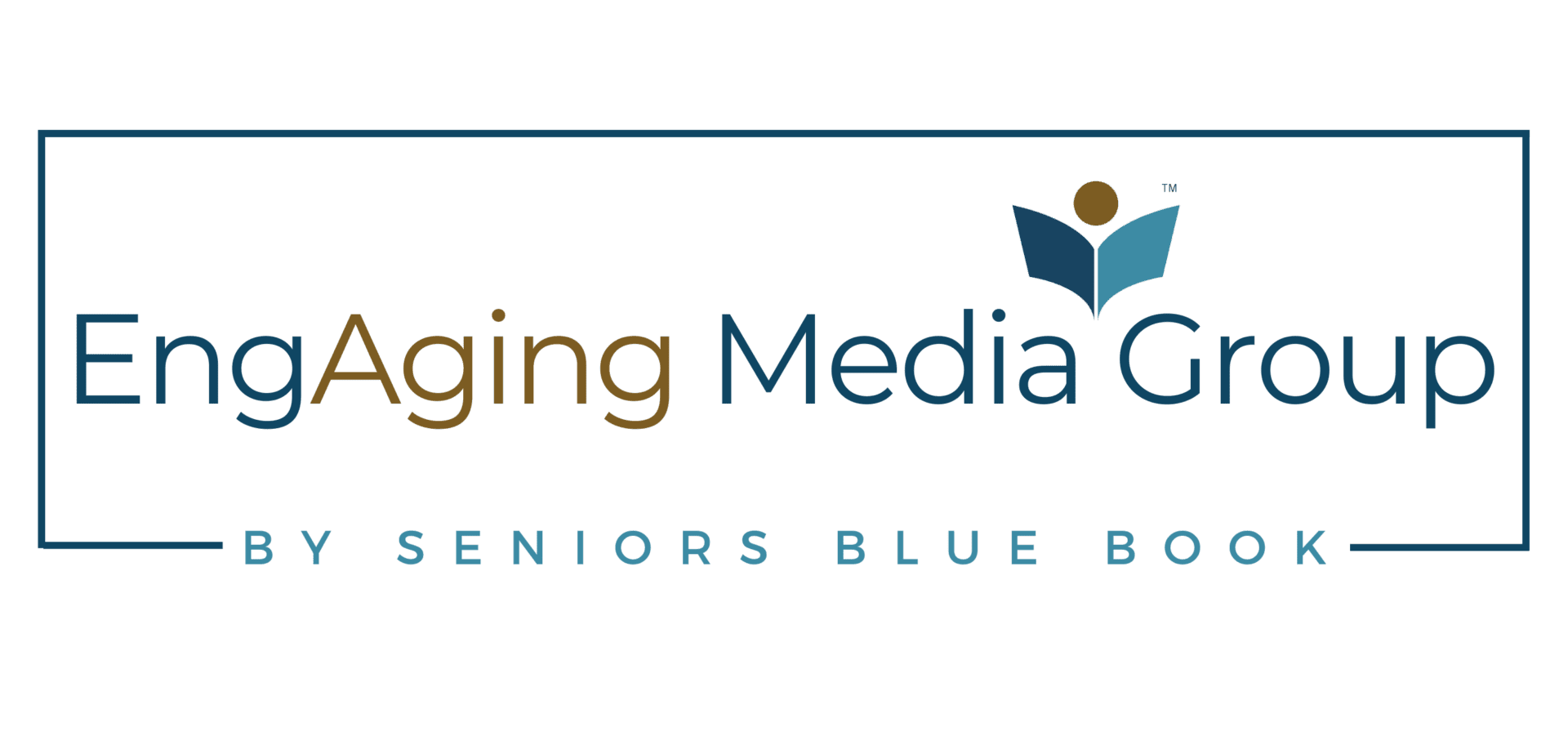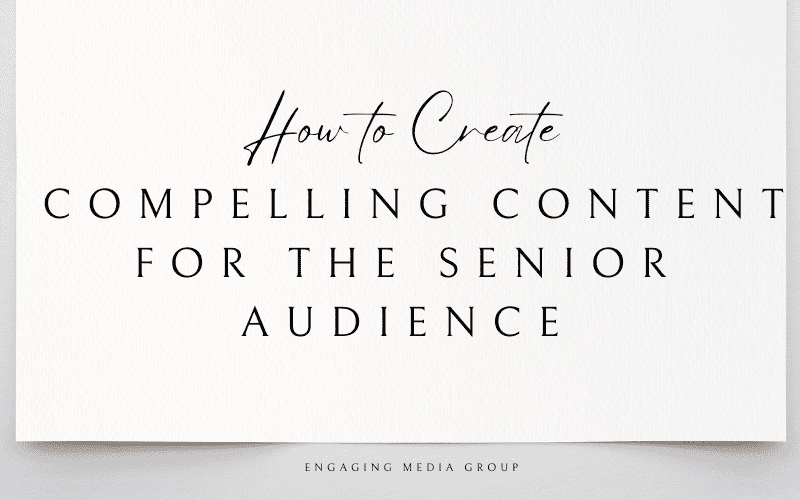It’s easy to get caught up in flashy trends and forget that not every audience responds the same way. For businesses serving older adults, creating compelling content means more than clever hashtags or viral challenges. It means building trust, delivering real value, and showing genuine respect for the needs, interests, and preferences of seniors and their families.
At Engaging Media Group, we specialize in helping senior-focused companies grow their brand visibility and connect meaningfully with their audience. In this post, we’ll break down what makes content compelling for seniors, what to avoid, and how to build strategies that lead to real engagement.
Understanding the Senior Audience
Before you start creating content, it’s important to understand the demographic you’re targeting. The “senior audience” is not a monolith. It includes active retirees, aging adults managing chronic conditions, and adult children seeking care solutions for their loved ones. Here are some key insights:
- Values Matter: Seniors appreciate sincerity, transparency, and usefulness. They respond well to brands that educate and empower rather than pressure or oversell.
- Clarity is Crucial: Simple, direct messaging works best. Avoid jargon or overly complex explanations.
- Trust is Everything: This demographic tends to be skeptical of digital advertising. That means content must be rooted in credibility—testimonials, real success stories, and clear information are essential.
What Compelling Content Looks Like
To capture attention and drive action, your content needs to connect on an emotional and practical level. Here are five types of content that consistently perform well with senior-focused audiences:
- Educational Blog Posts and Guides
- Topics like “How to Choose the Right Assisted Living Facility” or “Understanding Medicare vs. Medicaid” provide practical value.
- Break information into digestible sections, use clear headers, and include takeaway tips.
- Real-Life Testimonials and Case Studies
- Seniors and caregivers want to hear from others like them. Highlight stories of families who found support through your services.
- Use quotes, photos, and results-driven examples to build trust and relatability.
- Printable Resources and Checklists
- Many older adults prefer offline tools they can hold onto. Create downloadable PDFs, such as “Fall Prevention Checklist for the Home” or “5 Questions to Ask a Home Care Provider.”
- Videos with Subtitles and Clear Audio
- Keep videos short and focused. Avoid overly animated or fast-paced content.
- Subtitles are a must for accessibility. Include a clear speaker, gentle music, and topics that directly address concerns seniors face.
- FAQ or Myth-Busting Posts
- Address common misconceptions about senior services, home care, or aging itself.
- Format them in a Q&A style that’s easy to skim and share.
Best Practices When Creating Senior-Focused Content
Use a Friendly Yet Professional Tone: Speak respectfully and clearly. Avoid patronizing language or exaggerated claims.
Prioritize Accessibility: Ensure your fonts are readable, your site is easy to navigate, and your colors have high contrast. This isn’t just good practice—it’s essential for engaging older adults.
Be Mobile-Friendly: While many seniors use desktops, mobile use is rising. Make sure your content displays well on all screen sizes.
Build for SEO: Use keywords seniors or their families are searching for (e.g., “senior living near me,” “in-home care options,” “safe exercises for seniors”). But focus on quality over keyword stuffing.
Stay Consistent: Building trust takes time. A steady content schedule shows reliability and helps keep your brand top of mind.
Mistakes to Avoid
- Overusing Industry Jargon: If you wouldn’t say it to a friend, don’t put it in your content.
- Ignoring Caregivers: Many readers are adult children seeking services for their parents. Speak to their needs as well.
- Assuming Seniors Aren’t Tech-Savvy: Seniors are active online. Underestimating them could lead to missed opportunities.
- Skipping the “Why”: Don’t just say what your product does—explain how it helps improve quality of life.
Measuring What Matters
Tracking success with this audience may look different than traditional campaigns. Rather than just likes and clicks, focus on:
- Time spent on page
- Return visits
- Clicks to contact pages
- Resource downloads
- Comments and shares (especially in Facebook communities)
Final Thoughts
Creating compelling content for the senior audience isn’t about doing more—it’s about doing it with intention. The goal isn’t to sell a product. It’s to build relationships, ease fears, answer questions, and become a trusted source of guidance. When you get that right, engagement naturally follows.
Final Call to Action
Want to find out how your content is performing and what opportunities you’re missing? Contact Engaging Media Group at hello@engagingmediagroup.com for a FREE marketing consultation. We’ll provide a full content assessment, highlight your strengths, and share practical tips you can implement right away to improve engagement and visibility.
Understanding the Buyer’s Journey: How Seniors Make Purchase Decisions Online
When you picture someone researching a product or service online, you might imagine a younger adult scrolling through social media or watching product reviews on YouTube. But here’s the reality: adults aged 65 and older are becoming one of the fastest-growing segments of online consumers. And if your brand is focused on serving older adults or their families, understanding how they make purchase decisions online is no longer optional—it’s essential.
At Engaging Media Group, we specialize in helping senior-focused businesses grow their digital presence. In this blog post, we’ll walk you through the three stages of the buyer’s journey, how seniors interact with content during each phase, and how your brand can effectively reach, educate, and convert this unique and valuable audience.
Stage 1: Awareness – Recognizing a Need
The buyer’s journey begins with awareness. At this stage, seniors (or often their adult children) realize they have a need or a problem. This might be something like:
- “I’m having trouble keeping up with household chores.”
- “My mom is starting to forget things more often.”
- “We need help getting to doctor appointments.”
During the awareness stage, seniors and their families are not looking for a specific product yet. They are seeking information, reassurance, and understanding. They often search online using phrases like “help for aging parent at home” or “signs of memory loss in seniors.”
What Your Business Should Do:
- Create educational blog posts, checklists, or downloadable guides that answer common questions.
- Use clear, accessible language with large fonts and user-friendly layouts.
- Optimize content for local SEO to ensure it shows up in search results for nearby families.
- Focus on empathy and clarity, not sales.
Stage 2: Consideration – Exploring Options
Once the need is clearly identified, seniors or their caregivers begin exploring solutions. This is the consideration phase. At this point, they may be comparing services, locations, and reviews. They are evaluating providers, reading testimonials, checking websites, and possibly calling for more information.
What Your Business Should Do:
- Ensure your website is professional, easy to navigate, and mobile-friendly.
- Provide clear service descriptions, pricing (if possible), and FAQs.
- Use video testimonials or staff introductions to build trust.
- Offer comparison guides or decision-making tools to help families evaluate their choices.
- Be responsive to inquiries through phone, contact forms, or live chat.
This is also the stage where a poor or outdated digital presence can immediately remove you from consideration. If your business isn’t easy to find or doesn’t provide the right information, they’ll move on to someone else.
Stage 3: Decision – Taking Action
Finally, the decision phase. At this point, the buyer is ready to act. They may book a tour, schedule a consultation, or make a purchase. Seniors and their families want reassurance that they are making the right choice.
What Your Business Should Do:
- Make your calls to action clear and visible: “Schedule a Tour,” “Call Now,” or “Request Information.”
- Offer limited-time promotions or bonuses to create urgency.
- Make it easy to contact you with a phone number, email, and contact form on every page.
- Continue reinforcing trust with badges, reviews, and professional associations.
Final Thoughts
Understanding the buyer’s journey isn’t just about mapping out steps—it’s about meeting seniors and their families with the right message at the right time. It’s about being empathetic, clear, and visible throughout their entire search.
At Engaging Media Group, we help senior-focused companies build powerful digital strategies that speak directly to older adults and their families. Whether you need a website overhaul, SEO guidance, or content that truly resonates with your audience, we’re here to help.
Final Call to Action:
Want to know how well your digital presence supports the buyer’s journey?
Contact Engaging Media Group today at hello@engagingmediagroup.com to schedule your FREE marketing consultation. We’ll provide a full assessment of your current strategy and share simple, actionable tips you can implement right away.
Let’s work together to reach more seniors, build trust, and grow your brand.

